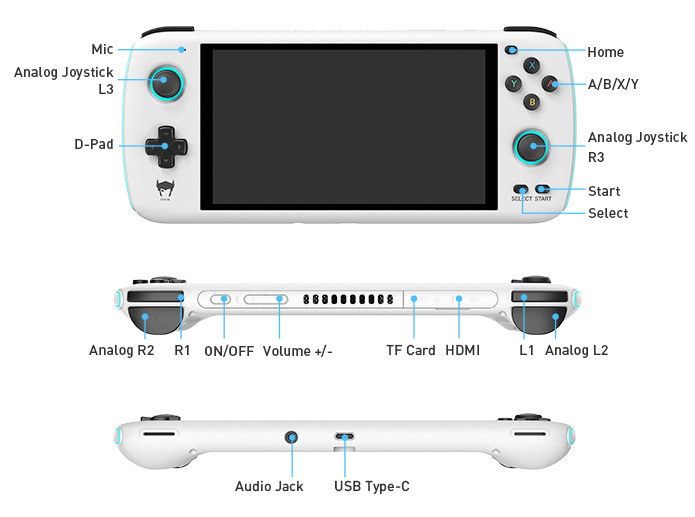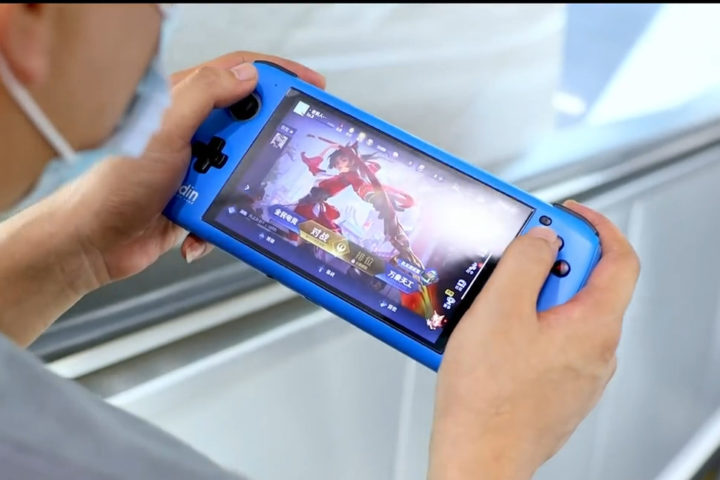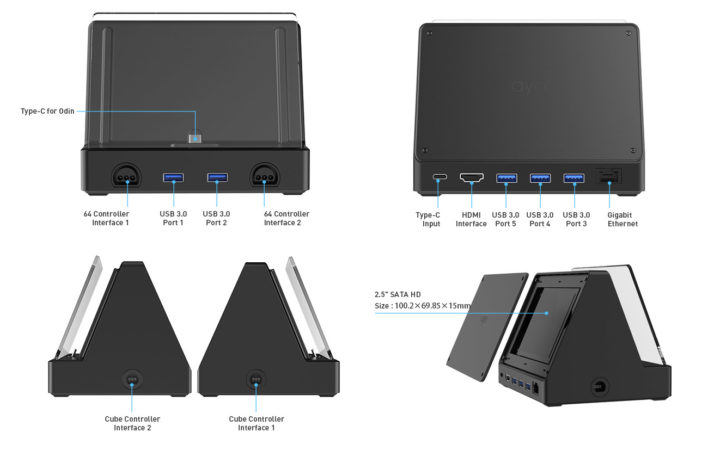AYN Odin is a 6-inch portable game console powered by Qualcomm Snapdragon 845 or MediaTek Dimensity 900 processor and offered with an optional dock with an HDMI port to connect it to a large screen, various ports for controllers, and even a 2.5-inch SATA bay.
It offers a much more powerful experience, a larger display, a more recent Android 10/11 OS, and better multiplayer abilities than the Amlogic S905D3 powered Powkiddy A20 portable game console we have just covered.
Three models of the Odin are offered with the Lite, Base, and Pro model differing in terms of processors, and/or storage and memory:
- SoC
- Odin Lite – MediaTek Dimensity 900 octa-core processor with 2x Cortex-A78 cores @ 2.4 GHz, 6x Cortex-A55 cores @ 2.0 GHz, Mali-G68 MC4 GPU
- Odin Base/Pro – Qualcomm Snapdragon 845 octa-core processor with 4x Kryo Gold (Cortex A75) cores @ 2.8 GHz, 4x Kryo Silver (Cortex A55) cores @ 1.8 GHz, Adreno 630 GPU
- System Memory and Storage
- Odin Lite/Base – 4GB LPDDR4x, 64GB UFS 2.1, MicroSD card slot
- Odin Pro – 8GB LPDDR4x, 128GB UFS 2.1, MicroSD card slot
- Display
- 5.98-inch IPS display with touchscreen, 1920×1080 resolution, Dragontail glass
- Mini HDMI for connection to external display
- Audio – 3.5mm audio jack, 2x 1W speakers, built-in microphone
- Connectivity
- Odin Lite – 802.11b/g/n/ac/ax WiFi 6 and Bluetooth 5.2
- Odin Base/Pro – 802.11b/g/n/ac WiFi 5 and Bluetooth 5.0
- User input – 2x analog joysticks, D-Pad, A/B/X/Y buttons, Start and Select buttons, Home buton, R1, R2, L1, L2, M1, and M2 buttons. Power and volume buttons.
- USB – USB 3.1 Type-C port
- Battery
- Odin Lite/Base – 5,000 mAh with fast charging
- Odin Pro – 6,000 mAh with fast charging (QC 4.0+)
- Dimensions – 224 x 95 x 15 mm

There’s also a Super Dock which can provide a better multiplayer experience with connecting to an HDMI TV, USB ports, and 64 and Cube controllers interfaces. The dock also adds Gigabit Ethernet and a 2.5-inch SATA bay which could be useful for local video playback. So that means the Odin could be used a portable gaming console on the go, and when connected to a dock, it would become a multiplayer gaming console, a media center, or even an Android PC, although there’s no specific desktop interface that I could see.
Odin very recently launched on Indiegogo and has raised over $500,000 so far. Early-bird rewards start at $175, $209, and $265 for respectively the Lite, Base, and Pro versions. The dock adds an extra $50, while shipping costs between $6 (to China) and $50 (to the UAE). The Qualcomm models should start to ship first in November 2021, followed by the MediaTek console in December 2021. But note that delays are frequent in crowdfunding campaigns, so be prepared for an eventual 2022 delivery.
Via Liliputing

Jean-Luc started CNX Software in 2010 as a part-time endeavor, before quitting his job as a software engineering manager, and starting to write daily news, and reviews full time later in 2011.
Support CNX Software! Donate via cryptocurrencies, become a Patron on Patreon, or purchase goods on Amazon or Aliexpress






